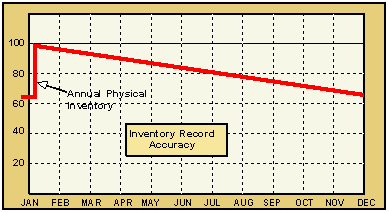|
 In
a physical inventory audit, normal operations cease while every inventory item is identified and
counted. The physical counts are then compared to records and, where necessary, the record is
corrected. In
a physical inventory audit, normal operations cease while every inventory item is identified and
counted. The physical counts are then compared to records and, where necessary, the record is
corrected.
Most firms conduct the physical inventory for financial reasons. However, it also has the
effect of correcting errors and improving cycle count programs. Within a few days, accuracy can
increase, quickly and dramatically to 98%+.
Then, as figure 2 shows, accuracy begins to drop the moment operations resume. Transactions
introduce errors. At one year, accuracy will drop to the initial level, other factors being
equal.
Figure 2 shows an initial IRA of 63%. Such a low figure is not too unusual. After the annual
inventory in January, IRA rose to about 99%. It then steadily declined to the original 63% by
the following December. This gives an overall average of about 80%.
This could be improved by taking a physical inventory every six months.
However, this is expensive and frustrating for people. It still gives only a 90% or so average IRA and
this is insufficient for MRP/ERP systems. It is undesirable even in manual systems.
For many, it is an unpleasant
experience of chaos and boredom. A physical inventory is expensive. It usually involves overtime
and sales may suffer. If the result is inaccurate, the money is wasted.
|

Figure 2-IRA With Physical Inventory
Planning Your Physical Inventory
The key to an accurate, sane and fast inventory is planning. Begin planning at least twelve
weeks before the count. Include at least the basic tasks below.
|





